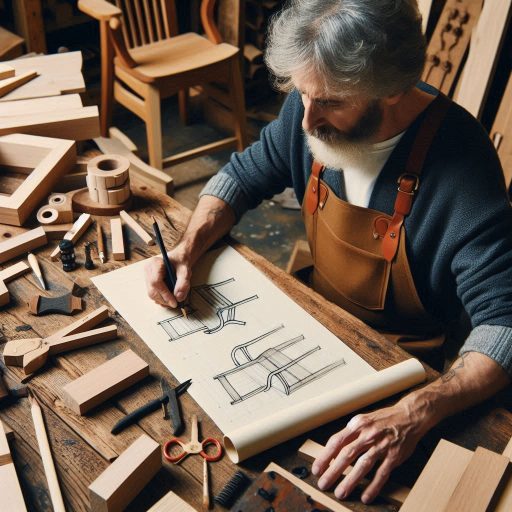Introduction
Art direction plays a vital role in shaping the visual identity of a brand or project.
It involves guiding the overall aesthetic, from color schemes to typography, ensuring that every visual element aligns with the intended message.
Whether for branding, advertising, or media production, art direction helps maintain consistency in design, reinforcing the brand’s identity.
This consistency not only strengthens recognition but also creates a unified experience for the audience, making it easier for them to connect with the brand.
In today’s saturated market, standing out has never been more important.
A unique art direction style can give a brand its edge, capturing attention and making it memorable.
Visuals are one of the first things people notice, and a distinct style can immediately set a brand apart from its competitors.
This differentiation is essential for fostering a strong brand identity, especially when every brand is fighting for the same audience’s attention.
A well-crafted art direction can establish trust and leave a lasting impression, encouraging deeper engagement with the audience.
Understanding Your Brand or Project
To develop a unique art direction style, begin by thoroughly understanding your brand or project.
Art direction is not just about aesthetics but about creating a visual identity that aligns with your core values and goals.
The Core Values, Target Audience, and Overall Message of Your Brand or Project
Start by analyzing the foundation of your brand or project.
What does it represent? What are its core values? Defining these elements will guide the direction of your visual style.
Next, identify your target audience.
Knowing who you are speaking to is critical for effective visual communication.
Are you reaching out to young professionals, families, or creative entrepreneurs? Each group responds to different visual cues.
Your art direction should cater to the tastes and preferences of the audience you want to engage with.
This ensures that your visual message resonates with those who matter most.
The Emotions and Feelings You Want to Evoke Through Your Visual Communication
Once you’ve analyzed the core values and target audience, determine the emotions you want to evoke.
Art direction has the power to influence how people feel when they interact with your brand.
Do you want them to feel inspired, excited, or calm? Understanding the emotions you wish to evoke will shape the visual elements you choose, including color, composition, and texture.
For example, warm tones and playful typography may evoke joy, while minimal designs with neutral colors can create a sense of calm.
Key Elements That Define Your Brand, Such as Color Scheme, Typography, and Imagery
Now, focus on the key visual elements that define your brand.
These elements are the foundation of your art direction style.
Start with your color scheme.
Colors are powerful tools in shaping perceptions.
Choose a color palette that reflects your brand’s personality and emotions.
For instance, bold, vibrant colors suggest energy, while muted tones evoke sophistication.
Typography is another key component.
The right fonts can communicate professionalism, creativity, or approachability.
Select typefaces that align with the overall mood and message of your brand.
Ensure consistency by using these fonts across all communication platforms.
Imagery is the third essential element.
The images you choose can speak volumes about your brand or project.
Whether you opt for sleek photography, bold illustrations, or abstract graphics, your imagery should align with your brand’s values and resonate with your audience.
Imagery brings your story to life, so it’s important to maintain consistency in both style and tone.
In summary, developing a unique art direction style starts with a deep understanding of your brand’s core values, audience, and desired emotional impact.
With careful attention to visual elements like color, typography, and imagery, you can craft a compelling and consistent visual identity that resonates with your target audience.
Read: Top Skills Needed for a Successful Character Designer
Research and Inspiration
Explore Different Art Styles, Trends, and Techniques to Gather Inspiration
Developing a unique art direction style starts with thorough research and a constant search for inspiration.
You need to explore various art styles, trends, and techniques to gather ideas that resonate with your vision.
Stay curious and open-minded, as inspiration can come from unexpected places, like a street mural, an old magazine, or a digital illustration.
Delve into both contemporary and historical art forms to understand how different movements have shaped creative expression.
Study the Work of Other Artists, Designers, and Brands to Understand What Resonates with You and Your Target Audience
Start by studying the work of other artists, designers, and brands that you admire.
Pay close attention to their use of color, composition, and storytelling techniques.
Analyze their visual language to see what connects with you and your audience.
By understanding their approaches, you can identify elements that you want to incorporate into your style while avoiding direct imitation.
The goal is to refine your vision, not replicate someone else’s work.
Create Mood Boards and Collect References to Help Develop Your Own Unique Art Direction Style
Mood boards are powerful tools for clarifying your creative direction.
Start by collecting references that evoke the emotions, colors, and themes you want to convey.
These references could be photographs, illustrations, typography samples, or even snippets of fashion or architecture.
By grouping these elements together, you can begin to see patterns in the visuals that attract you.
This process helps you define your aesthetic preferences and bring clarity to your creative choices.
Make sure to refine your mood boards regularly as you gather more references and adjust your vision.
This step is essential because it allows you to experiment with new ideas without losing focus.
The more specific and refined your mood boards are, the clearer your unique style will become.
In the end, your art direction style is a reflection of your personal experiences and inspirations.
By conducting thorough research, studying the work of others, and consistently creating mood boards, you will naturally develop a vision that stands out.
Your unique style will evolve over time, influenced by both external and internal factors.
Stay inspired, continue exploring, and never stop pushing the boundaries of your creative potential.
Read: Career Paths in Ceramic Art and Design
Experimentation and refinement
Start Experimenting with Different Visual Elements, Layouts, and Compositions
Experimentation is key when it comes to developing a unique art direction style and vision.
To begin, start by experimenting with different visual elements, layouts, and compositions.
You can explore various color palettes, typography, and textures to see what resonates with your brand or project.
This process allows you to discover combinations that may not seem obvious at first but can help define your unique style.
Be Open to Trying New Ideas and Techniques, Even if They May Seem Unconventional at First
Be bold and open to trying new ideas, even if they seem unconventional at the start.
The best way to grow as an art director is to push boundaries and step outside of your comfort zone.
Whether it’s mixing contrasting elements or playing with negative space, embracing innovation can lead to unexpected breakthroughs.
Experimentation should be a continuous process, where you are constantly refining your style and finding new ways to express your vision.
Gather Feedback from Colleagues, Mentors, or Focus Groups to Refine and Improve Your Art Direction Style
While you experiment, make sure to gather feedback.
Seek opinions from trusted colleagues, mentors, or even focus groups.
Feedback provides valuable insights into how others perceive your work and helps you make necessary adjustments.
You may notice patterns in the feedback that point to strengths or areas for improvement, giving you a clearer sense of direction.
Constructive criticism enables you to tweak your visual elements and hone your style until it fully aligns with your artistic vision.
Refining your art direction style is a process that doesn’t happen overnight.
It involves revisiting your work, analyzing what works and what doesn’t, and constantly improving.
Each iteration brings you closer to a more defined, cohesive style that feels both authentic and innovative.
Refinement means staying true to your brand or project’s identity while remaining adaptable and flexible to creative changes.
At times, your experiments may fail, but these failures are essential to growth.
They help you learn what doesn’t work and push you to think differently.
Successful refinement is built on a balance between creativity and discipline.
Don’t be afraid to abandon ideas that aren’t working.
Instead, use these opportunities to pivot in new directions, leading to a more polished and distinctive art direction style.
In short, experimentation and refinement are vital steps in developing a unique art direction style.
By trying new techniques, gathering feedback, and continuously refining your vision, you’ll create a style that stands out.
Don’t rush the process—allow it to evolve naturally and embrace every step as a part of the journey to artistic excellence.
Read: Freelance Character Design: How to Get Started

Consistency and Cohesiveness
Strive for consistency across all visual touchpoints, including website, social media, packaging, and advertising
Developing a unique art direction style requires consistency and cohesiveness across all visual touchpoints.
This consistency ensures that every aspect of your brand communicates the same vision.
Whether it’s your website, social media, packaging, or advertising, each visual component must align seamlessly with your brand identity.
Transform Your Career Today
Unlock a personalized career strategy that drives real results. Get tailored advice and a roadmap designed just for you.
Start NowEnsure that your art direction style aligns with your brand’s values and message
Start by establishing a clear visual language that reflects your brand’s values and message.
Your audience should instantly recognize your brand no matter where they encounter it.
For example, using the same color palette, typography, and graphic elements across all platforms creates a unified, cohesive brand experience.
Consistency is crucial when maintaining brand recognition.
Customers are more likely to remember a brand that offers a cohesive visual identity.
If your social media posts feel disconnected from your website or packaging design, this inconsistency can confuse your audience and weaken brand loyalty.
To ensure your art direction style aligns with your brand, revisit your core values and message frequently.
Your visual style should echo the essence of your brand.
For example, if your brand values sustainability, choose colors, typography, and design elements that convey that message.
Natural tones, clean lines, and minimalistic designs can help reinforce that commitment.
Maintain a cohesive visual language by using the same color palette, typography, and graphic elements
Strive for visual harmony by choosing a color palette that complements your brand’s tone and personality.
A consistent color scheme across all platforms solidifies your brand in the minds of your audience.
This cohesion also extends to typography.
The fonts you choose should reflect your brand’s identity and be easy to read across various media.
Consistent typography creates uniformity while reinforcing your overall style.
Graphic elements also play a vital role in maintaining consistency.
Whether it’s icons, illustrations, or patterns, keep these elements in line with your established visual language.
For example, if you use minimalist icons on your website, keep that same style in your packaging or advertising.
It’s also essential to consider how your brand’s visual identity evolves over time.
Trends may change, but your core elements should remain intact.
If you update your design style, do it thoughtfully and in a way that still reflects your brand’s core identity.
In fact, a cohesive, consistent art direction style is essential for strong brand identity.
It builds trust, improves brand recognition, and creates an overall sense of professionalism that resonates with your audience.
Read: Career Paths: Becoming a Professional Character Designer
Evolving and Adapting
In the ever-changing world of design, evolving and adapting your art direction style is essential.
Staying up-to-date with design trends and technological advancements keeps your work relevant and fresh.
As the creative landscape shifts, so should your approach to art direction.
Remaining stagnant can cause your style to feel outdated, which could affect your impact and success.
Stay Up-to-Date with Current Design Trends and Technological Advancements
Begin by continuously researching current design trends in your field.
Follow industry leaders, read design publications, and explore creative platforms like Behance or Dribbble.
New trends often reflect the cultural zeitgeist and shifting preferences in visual storytelling.
By staying informed, you can incorporate fresh elements into your art direction style.
These updates help align your vision with the current market while maintaining originality.
Technology plays a key role in modern design evolution.
As tools and software develop, they open up new possibilities for creativity.
Stay familiar with the latest design programs, digital tools, and emerging technologies to enhance your work.
Experimenting with new software can lead to innovative approaches that distinguish your art direction from others.
Understanding these advancements allows you to push boundaries and maintain a forward-thinking perspective.
Be Open to Evolving Your Style as Your Brand or Project Grows and Matures
Being open to evolving your style as your brand or project grows is crucial.
Projects may take unexpected turns, requiring you to adapt visually to meet new demands.
For instance, a company’s rebranding efforts might call for a complete style overhaul.
Embrace these changes as opportunities for growth and evolution.
Adapting your vision to reflect the maturity of a brand ensures your work remains aligned with its identity while keeping your style fresh.
Continuously Seek Feedback and Opportunities for Improvement
Feedback is an invaluable tool in the refinement process.
Consistently seek feedback from clients, peers, and collaborators to improve your art direction vision.
Constructive criticism can shed light on areas that may need development or adjustment.
Rather than viewing feedback as negative, use it to guide your creative growth and ensure your work resonates with its audience.
Opportunities for improvement should be welcomed, not feared.
Consider attending workshops, networking events, or design conferences to gain insights from other professionals.
These interactions offer fresh perspectives that can inspire new directions for your work.
By continually learning, you keep your style evolving and your vision sharp.
Ultimately, evolving your art direction style requires both awareness and adaptability.
Staying up-to-date with trends and technology ensures you remain relevant in the industry.
Openness to change, combined with seeking regular feedback, refines your vision and pushes your creative boundaries.
Through this process, your style will grow and evolve, keeping your work compelling and impactful.
Conclusion
Developing a unique art direction style and vision is crucial for any creative professional.
Throughout this blog post, we explored several key aspects that contribute to defining a distinctive artistic identity.
First, we discussed the importance of clarity in your vision.
A clear vision provides direction and purpose for your projects.
Next, we highlighted the need to gather inspiration from diverse sources.
Inspiration fuels creativity and expands your artistic horizons.
Explore various art forms, cultures, and design styles to find what resonates with you.
Use platforms like Pinterest or Instagram to curate mood boards that reflect your vision.
Experimentation plays a vital role in the development of your art direction style.
Try different techniques, colors, and compositions to discover what best represents your ideas.
Don’t be afraid to push boundaries and challenge norms.
This exploration can lead to surprising and innovative results.
Additionally, we emphasized the significance of cohesion in your work.
A cohesive art direction unifies your projects and enhances their impact.
Ensure that your visual elements consistently reflect your brand’s identity.
This consistency builds recognition and trust among your audience.




